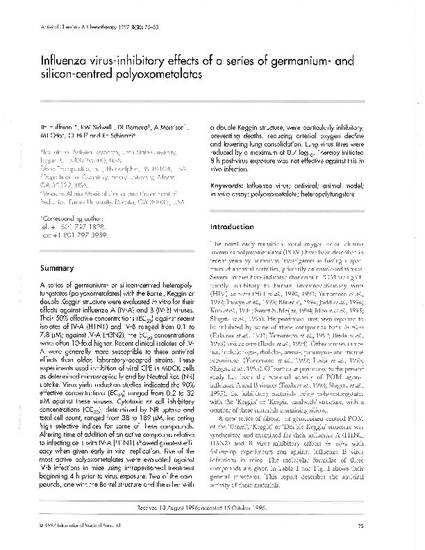
A series of germanium- or silicon-centred heteropolytungstates (polyoxometalates) with the Barrel, Keggin or double Keggin structure were evaluated in vitro for their effects against influenza A (IV-A) and B (IV-B) viruses. Their 50% effective concentrations (EC50) against recent isolates of IV-A (H1 N1 ) and IV-B ranged from 0.1 to 7.8 μM; against IV-A (H3N2), the EC50 concentrations were often 10-fold higher. Recent clinical isolates of IV-A were generally more susceptible to these antiviral effects than older, laboratory-adapted strains. These experiments used inhibition of viral CPE in MDCK cells as determined microscopically and by Neutral Red (NR) uptake. Virus yield reduction studies indicated the 90% effective concentrations (EC90) ranged from 0.2 to 32 μM against these viruses. Cytotoxic or cell inhibitory concentrations (CC50), determined by NR uptake and total cell count, ranged from 38 to 189 μM, indicating high selective indices for some of these compounds. Altering time of addition of an active compound relative to infecting cells with IV-A (H1 N1 ) showed greatest efficacy when given early in viral replication. Five of the most active polyoxometalates were evaluated against IV-B infections in mice using intraperitoneal treatment beginning 4 h prior to virus exposure. Two of the compounds, one with the Barrel structure and the other with a double Keggin structure, were particularly inhibitory, preventing deaths, reducing arterial oxygen decline and lowering lung consolidation. Lung virus titres were reduced by a maximum of 0.7 log10. Therapy initiated 8 h post-virus exposure was not effective against this in vivo infection.

Originally published by International Medical Press. Publisher's PDF available through remote link.
http://www.intmedpress.com/index.cfm?pid=16